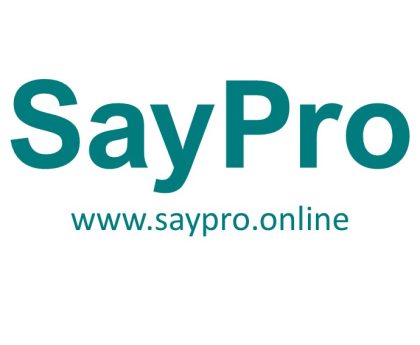SayPro Supplier Engagement and Negotiation Negotiate better pricing or delivery terms with suppliers based on performance and market conditions from SayPro Monthly January SCMR-17 SayPro Monthly Inclusive Design: Ensure the site is accessible to users with disabilities by SayPro Online Marketplace Office under SayPro Marketing Royalty SCMR
Objective: Strengthen supplier relationships and improve cost-efficiency by negotiating better pricing or delivery terms, leveraging supplier performance, market conditions, and the long-term nature of the partnership.
1. Review Supplier Performance and Market Conditions
- Evaluate Supplier Performance:
- Assess key metrics like on-time delivery, product quality, communication efficiency, and overall reliability. Track these metrics through regular performance reviews and internal reports.
- If a supplier consistently meets expectations—on-time, quality products, and minimal issues—use this as leverage when negotiating better terms, as a reward for their reliability and efficiency.
- Monitor Market Conditions:
- Stay informed about market trends, such as raw material costs, fuel prices, shipping rates, and supply chain challenges that might affect product prices or availability. This information can help justify negotiations with suppliers for more favorable pricing or delivery terms.
- Assess competitor prices to ensure that SayPro remains competitive in the marketplace and adjusts its negotiations accordingly.
- Identify Opportunities for Cost Reduction:
- Leverage market conditions where pricing pressure or competition may allow suppliers to offer better terms, such as volume discounts, or reduced shipping fees due to improved logistics or the introduction of new suppliers.
2. Leverage Volume and Consistency in Orders
- Highlight Long-Term Partnership Potential:
- If SayPro has been a consistent buyer from the supplier, use this as leverage to secure more favorable pricing or delivery terms. Emphasize the potential for increased or stable order volumes, which provide suppliers with a predictable, ongoing business relationship.
- Negotiate Discounts Based on Volume:
- Offer suppliers long-term volume commitments in exchange for price reductions. For example, committing to purchase larger quantities or setting up a long-term partnership can help lock in better pricing for SayPro.
- Suggest early payments in exchange for discounts, offering an attractive financial incentive to suppliers to maintain favorable rates.
- Consolidate Orders Across Product Categories:
- If SayPro orders products from multiple categories, negotiate with suppliers to consolidate orders across categories in exchange for better terms or reduced shipping costs.
3. Align Terms with Delivery and Lead Time Expectations
- Improve Delivery Schedules:
- Work with suppliers to ensure that products are delivered according to SayPro’s needs. Negotiate shorter lead times or guaranteed delivery windows, ensuring that product availability aligns with customer demand.
- Negotiate with suppliers for early or expedited shipping during peak demand periods (e.g., holidays or sales events) to avoid stockouts.
- Adjust Payment Terms Based on Delivery Performance:
- Tie payment terms to delivery performance. For example, if suppliers consistently meet delivery schedules, consider offering flexible payment terms or early payments. Conversely, if suppliers fail to meet deadlines, negotiate more favorable terms or longer payment windows.
4. Adjust to Market Fluctuations
- Negotiate Based on Economic Trends:
- If market conditions indicate that costs for raw materials or labor are rising, negotiate with suppliers to lock in pricing or limit price increases for a defined period to mitigate inflationary pressures.
- In times of market instability (e.g., economic downturns, supply chain disruptions), renegotiate pricing terms to adjust for increased costs while ensuring that product quality and delivery times remain intact.
- Negotiate Flexible Pricing Models:
- Introduce price-adjustment clauses based on material cost fluctuations or changing market conditions. This ensures that both SayPro and the supplier remain protected from extreme price swings while maintaining a stable relationship.
- Consider Sourcing Alternatives:
- If price fluctuations become too frequent, explore alternatives such as dual sourcing, where SayPro can source products from multiple suppliers at different price points. This strategy reduces dependence on any single supplier and provides negotiating leverage to maintain more favorable pricing.
5. Foster Long-Term Relationships and Mutual Benefits
- Reward Consistent Performance with Better Terms:
- As suppliers consistently meet SayPro’s needs and deliver quality products on time, reward them with favorable terms, such as longer contracts, bulk order commitments, or higher order volumes.
- Collaborative Problem Solving:
- In situations where suppliers face challenges (e.g., production delays, raw material shortages), work collaboratively with them to find mutually beneficial solutions, such as extending delivery timelines or adjusting orders, rather than imposing penalties.
- Build Trust with Transparency:
- Maintain open and honest communication about SayPro’s needs, expectations, and any changes to order volume, delivery schedules, or pricing expectations. Transparency fosters stronger, more trusting relationships, making negotiations more efficient.
- Supplier Development Programs:
- Invest in supplier development by working together to improve product quality, streamline operations, and optimize costs. This not only strengthens the supplier relationship but also enables SayPro to secure better terms over time.
6. Evaluate Alternative Suppliers for Competitive Leverage
- Explore Supplier Competition:
- Assess alternative suppliers regularly, especially if they can offer better pricing or more favorable terms. Bringing up alternative suppliers during negotiations can push existing suppliers to improve their offers, providing SayPro with stronger terms and competitive pricing.
- Benchmark Pricing Across Suppliers:
- Periodically review pricing across multiple suppliers for the same products. Use this information to push for better pricing or terms with existing suppliers or to make changes in sourcing when necessary.
- Consider the Total Cost of Ownership (TCO):
- While negotiating lower product prices, also consider the total cost of ownership, including shipping fees, handling, and return policies. Sometimes, paying slightly more for a supplier with more efficient logistics or better quality products can offer long-term savings and reduce operational costs.
7. Document Agreements and Terms
- Formalize Negotiated Terms:
- Ensure that all negotiated pricing, delivery schedules, and payment terms are documented in formal contracts or agreements. This prevents misunderstandings and protects both parties.
- Track Supplier Performance Against Agreements:
- Regularly track and evaluate the supplier’s performance against agreed terms, including price consistency, on-time delivery, and product quality. This allows SayPro to quickly identify areas where renegotiation or corrective actions are needed.
- Create a Supplier Scorecard:
- Maintain a supplier scorecard that tracks the key performance indicators (KPIs) established during negotiations. This helps measure how well suppliers are meeting expectations and provides data for future negotiations.
Conclusion
Negotiating better pricing and delivery terms with suppliers based on performance and market conditions is crucial for maintaining a competitive edge in the marketplace. By leveraging supplier performance data, staying informed about market trends, and fostering long-term, collaborative relationships, SayPro can ensure both cost-efficiency and reliability in its supply chain. Regular evaluations and open communication will strengthen these relationships, allowing for better terms and mutual growth.



